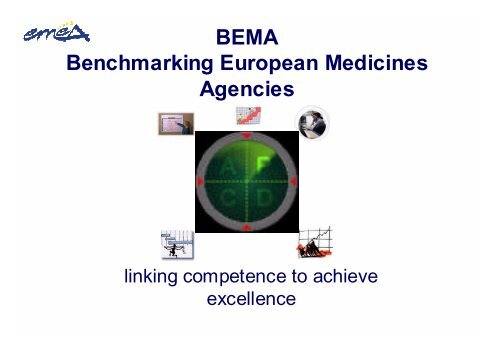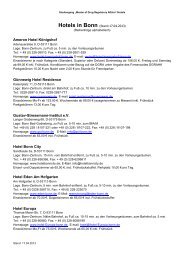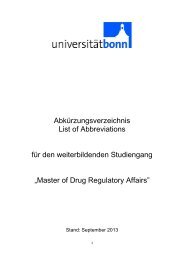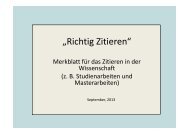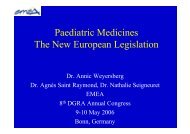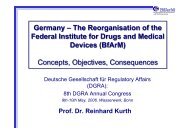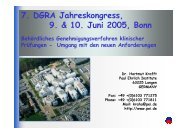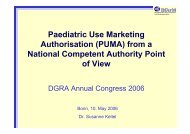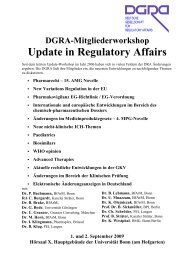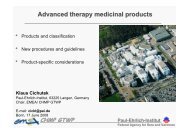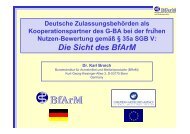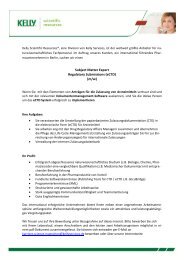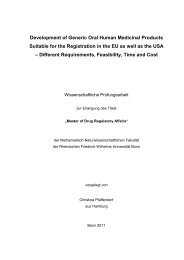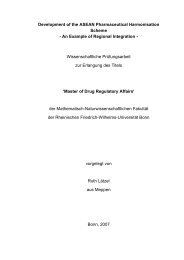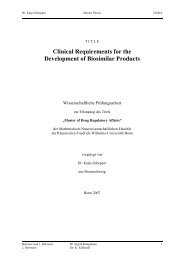BEMA Benchmarking European Medicines Agencies - DGRA
BEMA Benchmarking European Medicines Agencies - DGRA
BEMA Benchmarking European Medicines Agencies - DGRA
Create successful ePaper yourself
Turn your PDF publications into a flip-book with our unique Google optimized e-Paper software.
<strong>BEMA</strong><br />
<strong>Benchmarking</strong> <strong>European</strong> <strong>Medicines</strong><br />
<strong>Agencies</strong><br />
linking competence to achieve<br />
excellence
EU/EEA <strong>Medicines</strong> Network<br />
linking loose pearls<br />
to<br />
a chain
EU/EEA <strong>Medicines</strong> Network<br />
linking loose pearls<br />
to<br />
a chain<br />
without any weak<br />
link
EU/EEA <strong>Medicines</strong> Network<br />
linking loose pearls<br />
to<br />
a chain<br />
without any weak<br />
link<br />
How to ensure<br />
Consistency<br />
Quality?<br />
Good Regulatory Practices?
Good Regulatory Practices (GRP)<br />
A quality system<br />
to ensure that the users of medicinal products,<br />
the applicants and the regulators are satisfied<br />
with the scientific advice, opinions,<br />
the establishment of Maximum Residue Levels,<br />
inspection and assessment reports and related<br />
documents,<br />
taking into consideration legal requirements and<br />
guidance in order to protect and promote human<br />
and animal health.
As any Agency<br />
any body<br />
has its<br />
(integrated)<br />
quality management system
The virtual Agency<br />
needs<br />
its<br />
integrated<br />
quality management system
EU/EEA <strong>Medicines</strong> Network<br />
Building a <strong>Medicines</strong> <strong>Agencies</strong>’ Network<br />
implies<br />
the need<br />
to address management<br />
and logistics<br />
and not only key/core tasks<br />
foreseen in the regulatory framework<br />
Hence the need for<br />
BENCHMARKING
EU/EEA <strong>Medicines</strong> Network<br />
What is<br />
BENCHMARKING<br />
of<br />
EUROPEAN MEDICINES AGENGIES<br />
<strong>BEMA</strong>?<br />
Compare<br />
to enrich, to learn, to find best practices,<br />
which are (cost)-effective, efficient,<br />
feasible
ACT<br />
PLAN<br />
COMPARE <strong>BEMA</strong><br />
CHECK<br />
for continuous improvement<br />
DO
Difference between benchmarking<br />
process, audits and inspections<br />
<strong>Benchmarking</strong> is not focussing on noncompliance/non-conformities*,<br />
<strong>Benchmarking</strong> tries to reveal the<br />
strengths, the innovative, cost-effective<br />
and efficient approaches.<br />
The best practices encountered should<br />
be the ones we should aim for all together.<br />
* It is evident that opportunities for improvement are addressed by management
Difference between benchmarking<br />
process, audits and inspections<br />
<strong>Benchmarking</strong> is not focussing on noncompliance/non-conformities*,<br />
<strong>Benchmarking</strong> tries to reveal the<br />
strengths, the innovative, cost-effective<br />
and efficient approaches.<br />
The best practices encountered should<br />
be the ones we should aim for all together.<br />
Hence the need to describe them well<br />
* It is evident that opportunities for improvement are addressed by management
EU/EEA <strong>Medicines</strong> Network<br />
linking loose pearls<br />
to<br />
a chain<br />
without any weak<br />
link<br />
PERF III Quality Management Strategy<br />
in view of EU enlargement based on ISO<br />
9004:2000<br />
Let’s detect together<br />
the weak links in the chain<br />
and strengthen<br />
the network
ISO 9004:2000 rating scale was used in<br />
PERF III<br />
Important !
10 countries<br />
17 <strong>Agencies</strong><br />
assessed<br />
PERF III Quality Management Strategy<br />
in view of EU enlargement based on ISO 9004:2000<br />
Other advantage<br />
training<br />
of auditors<br />
&<br />
Quality Managers<br />
13-14 FEB 03<br />
HU Assessment<br />
Tailoring<br />
SA Questionnaire<br />
Implementation<br />
+<br />
Sel f-Asse ssment<br />
<strong>Benchmarking</strong><br />
Visits<br />
APR - NOV 03<br />
Opportunities for Improvement<br />
Quality Management Kick-off Meeting<br />
30 J AN 03: Self-Ass essment (SA) Q uesti onnaire<br />
2 "Qualit y Managers" per PAA + Li aison GMP I nsp.<br />
PERF II Benchmar king Del egation<br />
Date ?<br />
VU activities<br />
Tailoring<br />
SA Questionnaire<br />
Implementation<br />
+<br />
Sel f-Asse ssment<br />
<strong>Benchmarking</strong><br />
Visits<br />
APR - NOV 03<br />
Opportunities for Improvement<br />
Anonymous<br />
database<br />
20-21 MAR 03<br />
PhVigilance<br />
Tailoring<br />
SA Questionnaire<br />
Implementation<br />
+<br />
Sel f-Asse ssment<br />
ISO 9004<br />
Self-assessment<br />
Questionnaire<br />
PERF III<br />
<strong>Benchmarking</strong><br />
Visits<br />
APR - NOV 03<br />
Opportunities for Improvement<br />
+<br />
ISO 9004<br />
ISO 9004<br />
Questionnaire<br />
Self-assessment ISO 9004<br />
Self-assessment<br />
PAA-PERF Questionnaire<br />
Self-assessment<br />
III<br />
PAA-PERF Questionnaire III<br />
PAA-PERF III<br />
+<br />
Interface with<br />
inspections<br />
PERF= Pan-<strong>European</strong> Regulatory Forum
PERF III <strong>Benchmarking</strong><br />
resulted in the<br />
EU benchmarking system<br />
<strong>BEMA</strong><br />
applicable to all EU/EEA<br />
Competent Authorities<br />
for <strong>Medicines</strong><br />
(Human and Veterinary Use)
From PERF to EU <strong>Benchmarking</strong> System<br />
The PERF III benchmarking self-assessment was<br />
perceived as a useful tool for management of the<br />
interlinked <strong>Agencies</strong>, forming together a medicines<br />
agencies network in the EU/EEA,<br />
Therefore the <strong>European</strong> Commission assigned to the<br />
<strong>Medicines</strong> and Healthcare products Regulatory Agency<br />
(MHRA-UK) and the Paul-Ehrlich-Institut (PEI-Germany)<br />
the task to develop the EU benchmarking system further<br />
for medicines for human use.<br />
A similar task was assigned to the Irish <strong>Medicines</strong> Board<br />
for the veterinary medicinal products
From PERF to EU <strong>Benchmarking</strong> System<br />
For the <strong>Agencies</strong> involved in medicinal products for<br />
human use, a Steering Group consisting of delegates<br />
from MHRA, PEI, BfArM, the Italian, Finish and Czech<br />
<strong>Medicines</strong> <strong>Agencies</strong>, as well as EMEA, developed a<br />
questionnaire based on the PERF III questionnaires<br />
and the G10 key performance indicators, allowing to<br />
address a series of performance indicators for <strong>Agencies</strong><br />
involved in medicines for human use.<br />
Similarly Ireland together with Hungary and the EMEA<br />
started the tailoring of the questionnaire for use by<br />
<strong>Agencies</strong> for medicinal products for veterinary use.<br />
At the time the <strong>BEMA</strong> training course was shaped in<br />
October 2004 the separate questionnaires were in the<br />
process of being finalized.
From PERF, EU <strong>Benchmarking</strong> to <strong>BEMA</strong><br />
Since then, for cost benefit reasons and to address<br />
comments received after the training sessions, the<br />
questionnaires were merged and finalized after<br />
representatives from the Irish and French veterinary<br />
medicines agencies joined the Steering Group (SG)<br />
The name <strong>Benchmarking</strong> of <strong>European</strong> <strong>Medicines</strong><br />
<strong>Agencies</strong> <strong>BEMA</strong> was proposed<br />
The <strong>BEMA</strong>-SG also considered the concerns raised by<br />
the GMP inspection services working group related to<br />
the risk of duplicating the work of the Joint Audit<br />
Programme. The Heads of <strong>Medicines</strong> <strong>Agencies</strong><br />
decided on 24 FEB 05 in Reykjavik to continue with<br />
the questionnaire containing also GXP inspection<br />
related questions covering the interface with<br />
Inspection Services
The PERF benchmarking as well as the resulting<br />
current EU benchmarking system <strong>BEMA</strong> are<br />
addressing the G10 recommendations<br />
(Lisbon Agenda)<br />
using Key Performance Indicators<br />
derived from<br />
the G10 <strong>Medicines</strong> Report of 07 May 2002 and the 01 July 2003<br />
COMMUNICATION FROM THE COMMISSION TO THE COUNCIL,<br />
THE EUROPEAN PARLIAMENT, THE ECONOMIC AND SOCIAL<br />
COMMITTEE AND THE COMMITTEE OF THE REGION<br />
A Stronger <strong>European</strong>-based Pharmaceutical<br />
Industry for the Benefit of the Patient - A Call for<br />
Action COM (2003) 383 final.
The benchmarking process/methodology<br />
International standards at the basis of the approach<br />
The use of an International Standard and Guidance<br />
allows mutual understanding between partners<br />
worldwide.<br />
The subsequent tailoring of the questions to serve<br />
better the <strong>Medicines</strong> <strong>Agencies</strong> make the choice of<br />
a particular management model less relevant,<br />
although for the purpose of comparison and to serve<br />
these <strong>Agencies</strong> that have also the certification as an<br />
objective, the link with PERF III questions and ISO<br />
9004:2000 questions, as well as G10 and EU MJA<br />
(Joint Audit Programme JAP) is provided in the<br />
questionnaire.
EU <strong>Benchmarking</strong> Objectives<br />
Aim of the EU <strong>Benchmarking</strong> System <strong>BEMA</strong>:<br />
“To contribute to the development of a world<br />
class medicines regulatory system for<br />
medicinal products based on a network of<br />
agencies operating to best practice<br />
standards”.
Creating a world-class system<br />
Creating a world-class system:<br />
it sounds arrogant<br />
over-optimistic<br />
not very realistic.<br />
Will this really be possible for a<br />
network organisation if it is already<br />
difficult for one isolated enterprise?<br />
Just do it!
Visits by<br />
trained<br />
EU <strong>Benchmarking</strong><br />
System<br />
Assessors<br />
(Peer review team)<br />
EU <strong>Benchmarking</strong> System<br />
Strategy<br />
NOV03-MAY05<br />
NCA<br />
Implementation<br />
+<br />
Sel f-Asse ssment<br />
<strong>Benchmarking</strong><br />
Visits<br />
JUL 05-MAY06<br />
Opportunities for Improvement<br />
04, 25 OCT, DEC 04,<br />
MAR, JUN,SEP, DEC 05<br />
NOV03-MAY 05<br />
NCA<br />
Implementation<br />
+<br />
Sel f-Asse ssment<br />
<strong>Benchmarking</strong><br />
Visits<br />
JUL 05-MAY06<br />
Opportunities for Improvement<br />
Anonymous<br />
database<br />
Implementation<br />
+<br />
Sel f-Asse ssment<br />
ISO 9004<br />
+G10<br />
Self-assessment<br />
Questionnaire<br />
NOV03-MAY05<br />
NCA<br />
<strong>Benchmarking</strong><br />
Visits<br />
JUL 05-MAY06<br />
Opportunities for Improvement<br />
=<br />
ISO 9004<br />
+G10<br />
Self-assessment<br />
Questionnaire<br />
+<br />
Interface with<br />
inspections
Specific<br />
(Sub to Key)<br />
Performance<br />
Indicator<br />
Key Performance<br />
Indicator<br />
What will be rated?
Specific<br />
(Sub to Key)<br />
Performance<br />
Indicator<br />
Key Performance<br />
Indicator<br />
What will be rated?<br />
Note that the KPI is NOT the mathematical average of the SPIs
We rate in the same way using the ISO<br />
9004:2000 rating scale
Validation of the rating system is<br />
crucial for reliable data/baseline rating<br />
Criteria for <strong>BEMA</strong> assessors were established by the Steering<br />
Group and endorsed by Heads of <strong>Medicines</strong> <strong>Agencies</strong> (HMA) and<br />
are described in the <strong>BEMA</strong> maual. Lead assessors must have<br />
previous benchmarking or twinning experience<br />
Training and quarterly improvement <strong>BEMA</strong> seminars at EMEA<br />
(working group of <strong>BEMA</strong> assessors – train the trainer principle) with<br />
reimbursement (EMEA budget) of one delegate per Agency<br />
(<strong>Medicines</strong> for Veterinary and Human use)<br />
Logistics for planning, team composition, training (+manual) and<br />
coaching (hints and Q&A) of teams are EMEA task as per HMA<br />
decision<br />
Helpdesk for <strong>BEMA</strong> assessors (EMEA + MHRA + Paul Ehrlich<br />
Institute simultaneously to ensure prompt resolution of issue and<br />
feedback to <strong>BEMA</strong> Steering group)
Validation of the rating system is<br />
crucial for reliable data/baseline rating<br />
The <strong>BEMA</strong> 2005-2006 assessment by visiting peer review teams<br />
consisting of 3 <strong>BEMA</strong> assessors is part of the validation and<br />
continuous improvement of the system in view of the 2008 <strong>BEMA</strong><br />
assessment round.<br />
Since the HMA decided that the HMA secretariat is keyholder of the<br />
codes assigned to each assessment and EMEA receives batches of<br />
5 or more anonymous assessments, improvement action can’t be<br />
immediate as in PERF, but takes place quarterly.<br />
Training and quarterly improvement <strong>BEMA</strong> seminars will continue at<br />
EMEA (working group of <strong>BEMA</strong> assessors) to prepare in 2007 the<br />
2008 <strong>BEMA</strong> assessment round.<br />
Assessments will be repeated every 2-3 years with selfassessments<br />
annually at each Agency as management tool<br />
(monitoring of improvement actions and implementation of new<br />
legislation).
Validation of the rating system is crucial<br />
for reliable data/baseline rating
Validation of the rating system is<br />
crucial for reliable data/baseline rating<br />
Overrating should be avoided. Leading to<br />
overrating is the absence of verification of<br />
sustained improvement trends. How long is a<br />
system/procedure/policy and management<br />
review in use? That must be recorded to justify<br />
the rating.<br />
Evidence described must address the whole<br />
performance indicator and not just one of the<br />
examples given in the questionnaire.<br />
In the case documented procedures, or a<br />
documented system is in the question, it is<br />
really meant to be a documented system.
Validation of the rating system is<br />
crucial for reliable data/baseline rating<br />
One can NOT compare the results of an Agency<br />
assessed in January with one assessed in November<br />
of the same year. The time elapsed is used for<br />
continual improvement and one rates that effect in the<br />
first place. Hence the need for no more than 10 months<br />
for the network assessment.<br />
Average ratings per Agency are nonsense, since<br />
<strong>Agencies</strong> may have different regulatory tasks and<br />
different phases of implementation of new legislation.<br />
Average ratings of one particular performance indicator<br />
over the whole network constitutes the baseline value in<br />
view of the 2008 <strong>BEMA</strong> assessment.
Use of several portable PCs<br />
by assessors<br />
Allows work to be continued<br />
at hotel<br />
Don’t forget the adaptors!<br />
Very practical:<br />
PC projection in room for assessors<br />
Evidence instantly available on intranet
Tasks after the visit, communication and continual<br />
improvement<br />
In the <strong>BEMA</strong> system a database is required to hold anonymous<br />
results of the peer review visits (including the scores and the<br />
narrative/comments).<br />
The <strong>BEMA</strong> peer review team submits its full report/completed<br />
questionnaire to the visited agency to allow internal performance<br />
improvement plans to be put in place if needed and to control the<br />
anonymous database provided to the Agency after “cleaning”.<br />
In addition, an anonymised “cleaned” version is submitted by the<br />
peer review team and reviewed by the visited agency (QC step)<br />
The anonymous material is, after QC by the Agency and an<br />
additional verification by the assessors, mailed by courier to the<br />
HMA secretariat as per SOP, and after coding by the key holder<br />
forwarded to the EMEA for entry in the accumulated Access<br />
database.
Tasks after the visit, communication and continual<br />
improvement<br />
All participating agencies receive the<br />
anonymous data (rating and descriptions) listed<br />
per indicator.<br />
It is an HMA decision that data which are part of<br />
this management tool are not published.<br />
A report based on all data of the 2005-2006<br />
<strong>BEMA</strong> assessment will be provided to the HMA<br />
for the SEP 06 meeting.<br />
HMA decides about communication with<br />
stakeholders.
Tasks after the visit, communication and continual<br />
improvement<br />
VERY IMPORTANT for benchmarking: descriptions are of much<br />
more value than ratings.<br />
Owners of high ratings for particular indicators might volunteer<br />
to be known in order to allow other agencies to address questions<br />
and requests for advice to the best performers. In this way an<br />
Agency becomes a “benchmark consultant” for a particular<br />
indicator with high rating.<br />
And so we contribute to the development<br />
of a world class medicines regulatory system<br />
for medicinal products based on a network<br />
of agencies operating to best practice standards
The value of the growing database<br />
The longer the EU benchmarking system <strong>BEMA</strong> lasts<br />
the more assessments<br />
the larger the data base<br />
the more accurate the ratings will be<br />
the better tool to develop a world class medicines regulatory system


